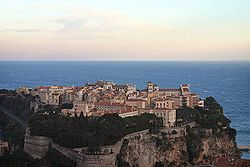- Monaco-Ville
-
Monaco-Ville (also known locally as French: Le Rocher or English: The Rock) is one of Monaco's administrative divisions located on a rocky headland that extends into the Mediterranean Sea. It is one of the four traditional quarters (French: quartiers) of Monaco, the others being La Condamine, Monte Carlo, and Fontvieille. However, in modern administrative terms it is one of ten wards (see navigation box below for a complete list). Therefore, Monaco-Ville is neither a town nor the capital of Monaco for which Monaco-Ville is erroneously taken by some people.[1]
Monaco-Ville is located at 43°44′15″N 7°24′55″E / 43.7375°N 7.41528°E and has estimated population of 1,151.
Contents
History
Monaco-Ville was originally called Monoikos, after the temple of Hercules Monoikos, which presumably was located in the nearby colony established by Phocaean Greeks in the 6th century BC. During its history, Monoikos passed hands a number of times. It became known as Monaco in the Middle Ages when a fortress was built on the Rock in the 13th century and later a fortified town. Some of the city walls still remain.
In 1297 the Rock was seized by François Grimaldi, a member of the Grimaldi family, which ruled Monaco since then with some brief interruptions. The Grimaldis made the old fortress their residence. Overtime the fortress evolved into the Palais Princier, which is now the official residence of Albert II, Prince of Monaco.
Landmarks
Despite being located in the middle of the City of Monaco, the world's most densely populated urban center, Monaco-Ville remains a medieval village at heart, made up almost entirely of quiet pedestrian streets and marked by virtual silence after sundown. Though innumerable people visit Monaco-Ville and the palace square, only local vehicles are allowed up to the Rock, and gasoline-powered motorcycles are prohibited after 10 pm.
- Palais Princier, the Prince's palace. The colourful changing of the guard occurs every day outside the Palais at 11:55 am.
- Saint Nicholas Cathedral (French: Cathédrale de Monaco), a Romanesque-Byzantine church that contains the remains of many members of the Monaco's ruling family. American-born Grace Kelly, Princess Grace of Monaco, the mother of Prince Albert II, is also buried there.
- Oceanographic Museum, established by Albert I, Prince of Monaco, in 1910.
- Chapelle de la Misericorde, built in 1639, one of the oldest buildings in the principality. It is famous for being the starting point of a torchlit religious procession by local residents that takes place on the eve of Good Friday each year.
See also
References
- ^ The official capital of Monaco is the City of Monaco, a municipality, which shares exactly the same territory with the country, the Principality of Monaco. Monaco is indeed a city-state. Source: Municipal Council of the Principality of Monaco
Coordinates: 43°43′51″N 7°25′27″E / 43.7309°N 7.4241°E
 Administrative divisions of Monaco
Administrative divisions of Monaco 
Traditional Quartiers 1 
Current Wards 2 01 Monte Carlo · 02 Saint Roman · 03 Larvotto · 04 La Condamine · 05 Monaco-Ville · 06 Fontvieille · 07 La Colle · 08 Les Révoires · 09 Moneghetti · 10 Saint Michel · 11 Le Portier 31 ordered by age of foundation • 2 ordered by official Ward number • 3 Planned for 2014 Categories:- Quarters of Monaco
Wikimedia Foundation. 2010.

